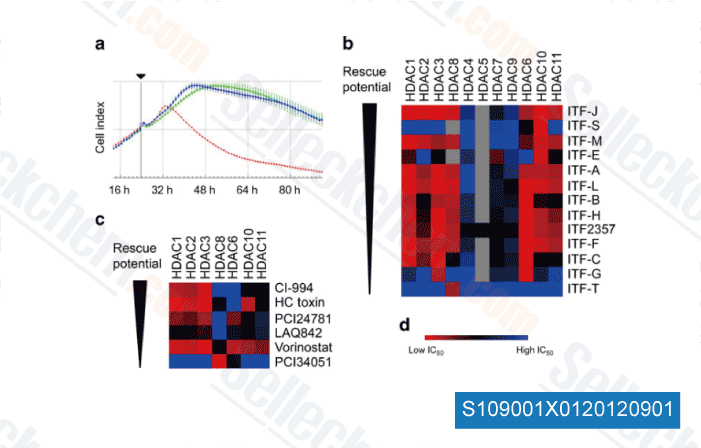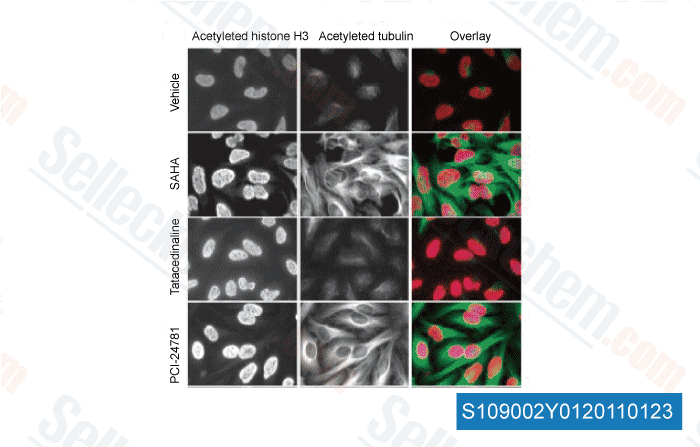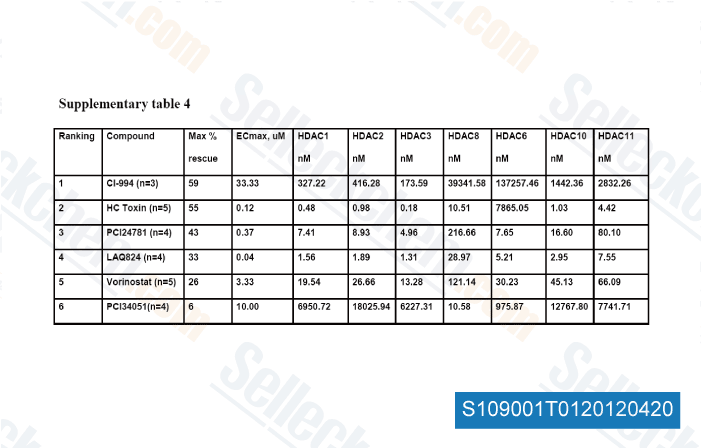|
Toll Free: (877) 796-6397 -- USA and Canada only -- |
Fax: +1-832-582-8590 Orders: +1-832-582-8158 |
Tech Support: +1-832-582-8158 Ext:3 Please provide your Order Number in the email. |
Technical Data
| Formula | C21H23N3O5 |
|||
| Molecular Weight | 397.42 | CAS No. | 783355-60-2 | |
| Solubility (25°C)* | In vitro | DMSO | Insoluble | |
| Water | Insoluble | |||
| Ethanol | Insoluble | |||
|
* <1 mg/ml means slightly soluble or insoluble. * Please note that Selleck tests the solubility of all compounds in-house, and the actual solubility may differ slightly from published values. This is normal and is due to slight batch-to-batch variations. * Room temperature shipping (Stability testing shows this product can be shipped without any cooling measures.) |
||||
Preparing Stock Solutions
Biological Activity
| Description | Abexinostat (PCI-24781, CRA-024781) is a novel pan-HDAC inhibitor mostly targeting HDAC1 with Ki of 7 nM, modest potent to HDACs 2, 3, 6, and 10 and greater than 40-fold selectivity against HDAC8. Phase 1/2. | |||||||||||
|---|---|---|---|---|---|---|---|---|---|---|---|---|
| Targets |
|
|||||||||||
| In vitro | PCI-24781 exhibits potent antitumor activity against a variety of tumor cell lines with GI50 ranging from 0.15 μM to 3.09 μM. PCI-24781 also has an antiproliferative effect on HUVEC endothelial cells with GI50 of 0.43 μM. PCI-24781 treatment causes dose-dependent accumulation of both acetylated histones and acetylated tubulin in HCT116 or DLD-1 cells, induces expression of p21, and leads to PARP cleavage and accumulation of the γH2AX. [1] Inhibition of HDAC enzymes by PCI-24781 leads to a significant reduction in the transcription of genes specifically associated with HR, including RAD51. Consistent with inhibition of HR, PCI-24781 treatment results in a decreased ability to perform homology directed repair of I-SceI-induced chromosome breaks in transfected CHO cells. [2] PCI-24781 induces S phase depletion, G2 cell cycle arrest, and apoptosis in soft tissue sarcoma (STS) cells. PCI-24781 induces Rad51 transcriptional repression in STS cells potentially mediated via enhanced E2F1 binding to the Rad51 proximal promoter. [3] PCI-24781 induces caspase and reactive oxygen species-dependent apoptosis through NF-κB mechanisms in Hodgkin lymphoma and non-Hodgkin lymphoma cell lines. [4] | |||||||||||
| In vivo | Administration of PCI-24781 at 200 mg/kg once daily every other day (q.o.d.) significantly inhibits the growth of HCT116 and DLD-1 xenografts in mice by 69% and 59%, respectively. Administration of PCI-24781 at 20 mg/kg, 40 mg/kg, 80 mg/kg, or 160 mg/kg once daily for 4 consecutive days followed by 3 days without treatment each week (q.d. × 4 per week) in the HCT116 model causes inhibition of tumor growth by 48%, 57%, 82.2%, or 80.0%, respectively. [1] |
Protocol (from reference)
| Kinase Assay:[1] |
|
|---|---|
| Cell Assay:[1] |
|
| Animal Study:[1] |
|
References
|
Customer Product Validation

-
Data from [ Biochem Bioph Res Co , 2012 , 55, 2421-31 ]

-
Data from [ Nat Biotechnol , 2011 , 29, 255-265 ]

-
Data from [ Biochem Bioph Res Co , 2011 , 414, 25-30 ]
Selleck's Abexinostat (PCI-24781) has been cited by 24 publications
| Heterogeneity-driven phenotypic plasticity and treatment response in branched-organoid models of pancreatic ductal adenocarcinoma [ Nat Biomed Eng, 2024, 10.1038/s41551-024-01273-9] | PubMed: 39658630 |
| Deciphering the Metabolic Basis and Molecular Circuitry of the Warburg Paradox in Lymphoma [ Cancers (Basel), 2024, 16(21)3606] | PubMed: 39518046 |
| Nuclear oligo hashing improves differential analysis of single-cell RNA-seq [ Nat Commun, 2022, 13(1):2666] | PubMed: 35562344 |
| Single-cell profiling-guided combination therapy of c-Fos and histone deacetylase inhibitors in diffuse large B-cell lymphoma [ Clin Transl Med, 2022, 12(5):e798] | PubMed: 35522945 |
| Small-molecule inhibitors of histone deacetylase improve CRISPR-based adenine base editing [ Nucleic Acids Res, 2021, 49(4):2390-2399] | PubMed: 33544854 |
| Epigenetic targeting of the ACE2 and NRP1 viral receptors limits SARS-CoV-2 infectivity [ Clin Epigenetics, 2021, 13(1):187] | PubMed: 34635175 |
| Combining APR-246 and HDAC-Inhibitors: A Novel Targeted Treatment Option for Neuroblastoma [ Cancers (Basel), 2021, 13(17)4476] | PubMed: 34503286 |
| Quantifying Drug Combination Synergy along Potency and Efficacy Axes. [ Cell Syst, 2019, 8(2):97-108] | PubMed: 30797775 |
| Epigenetic Reprogramming with Antisense Oligonucleotides Enhances the Effectiveness of Androgen Receptor Inhibition in Castration-Resistant Prostate Cancer [ Cancer Res, 2018, 78(20):5731-5740] | PubMed: 30135193 |
| Dual role of HDAC10 in lysosomal exocytosis and DNA repair promotes neuroblastoma chemoresistance. [ Sci Rep, 2018, 8(1):10039] | PubMed: 29968769 |
RETURN POLICY
Selleck Chemical’s Unconditional Return Policy ensures a smooth online shopping experience for our customers. If you are in any way unsatisfied with your purchase, you may return any item(s) within 7 days of receiving it. In the event of product quality issues, either protocol related or product related problems, you may return any item(s) within 365 days from the original purchase date. Please follow the instructions below when returning products.
SHIPPING AND STORAGE
Selleck products are transported at room temperature. If you receive the product at room temperature, please rest assured, the Selleck Quality Inspection Department has conducted experiments to verify that the normal temperature placement of one month will not affect the biological activity of powder products. After collecting, please store the product according to the requirements described in the datasheet. Most Selleck products are stable under the recommended conditions.
NOT FOR HUMAN, VETERINARY DIAGNOSTIC OR THERAPEUTIC USE.
